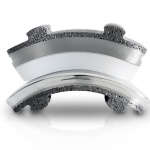Total Ankle Arthroplasty
Why does my ankle hurt?
A persistent stiff, swollen and painful ankle is likely due to arthritis, caused by the deterioration of cartilage and inflammation in the joint. Unlike arthritis in the hip and knee joints, which is usually a result of aging and the normal wear and tear of use (osteoarthritis), ankle arthritis is more frequently preceded by past injury such as an ankle fracture, multiple sprains, chronic instability of the joint, or by the malalignment of the leg.
This cartilage damage may lead to the tibia, one of the two bones comprising the lower leg, to rub or grind against the talus bone in the foot, resulting in pain during movement. In advanced cases, this pain leads to a loss of mobility and discomfort during daily activities such as walking or rising from a chair.
How can I relieve my ankle pain?
Your physician may recommend conservative treatments such as anti-inflammatory medication, physical therapy, bracing or steroid injections to treat the symptoms of ankle arthritis. If these treatments fail to provide relief, the most common surgical procedure has been an ankle fusion (arthrodesis), in which the tibia, fibula, and talus, the three bones making up the ankle joint, are joined together using metal screws. Because the bones grow together, the ability to have motion in the ankle the ankle is lost. More recently, Ankle Arthroplasty has proven highly effective in relieving the pain and symptoms of ankle arthritis while preserving motion in the ankle joint.
What is Ankle Arthroplasty?
Ankle arthroplasty, also known asankle replacement surgery, is a procedure that removes the damaged bone and cartilage of the ankle and replaces it with stronger prosthetic parts, specially designed to mimic the movement of your original joint. This procedure is an alternative to ankle fusion. Your physician will consider factors such as your condition, age, weight, and activity level to determine which procedure may be best for you.
When should I consider an ankle replacement or ankle fusion surgery?
You and your surgeon will address this question together. But in general, when conservative treatments fail or no longer provider relief and the level of your ankle pain interferes with your daily life, it is time to consider surgical treatment. Questions to ask include if your pain has caused you to give up activities you normally enjoy, if your pain interferes with your sleep at night, and if you are no longer as mobile as you would like to be.
How is ankle replacement surgery performed?
Depending on the patient, ankle arthroplasty may be performed in the hospital with an overnight stay, or as an out-patient procedure. Patients are put to sleep under general anesthesia and will have no awareness of the procedure while it is happening. An incision is made at the ankle. At Ortho Illinois, your surgeon makes the incision on the side of your ankle and the fibula is moved to the side to provide access to the joint. The benefits of this lateral approach are less disruption of the nerves and soft tissue surrounding the joint and allowing your surgeon to better see and position the ankle replacement implant more precisely. Less trauma to the nerves and tissue may lead to faster recovery and help restore a natural walking gait.
 The surgeon then removes portion of bone to allow for the placement of the implant components, which are secured in place using a special cement. Once the implant is in place, your surgeon repositions the fibula bone, securing it with a metal plate, and closes the incision.
The surgeon then removes portion of bone to allow for the placement of the implant components, which are secured in place using a special cement. Once the implant is in place, your surgeon repositions the fibula bone, securing it with a metal plate, and closes the incision.
What are the risks involved with ankle arthroplasty?
As with any surgery there are general risks including bleeding, blood clot and infection. While uncommon, ankle replacement surgery may have more specific risks which include ankle weakness, stiffness or instability; dislocation, or loosening of the artificial joint over time; nerve, blood vessel, tendon or ligament damage; pain and inflammation. Your surgeon will review these risks with you during your pre-surgical consult appointment.
How long is recovery after surgery?
Recovery will vary from patient to patient, and your surgeon will review their specific protocols for your post operative care. But in general you can expect to be in a splint or cast and non-weight bearing for up to 4 weeks. This immobilization period is important to encourage the healing of your incision and surgical area. Once your surgeon allows movement and weight bearing you will be fitted with a special walking boot for another 3-4 weeks. After this period you will return to wearing your own footwear and begin your physical therapy and exercises to build strength and mobility in your ankle joint.
What can I expect after ankle arthroplasty?
Patients undergoing a total ankle replacement can find the procedure to be a life-changer. Research supports the procedure’s effectiveness in providing patients with significantly less pain and better function. Patients are able to resume the more active and pain-free life they enjoy.
